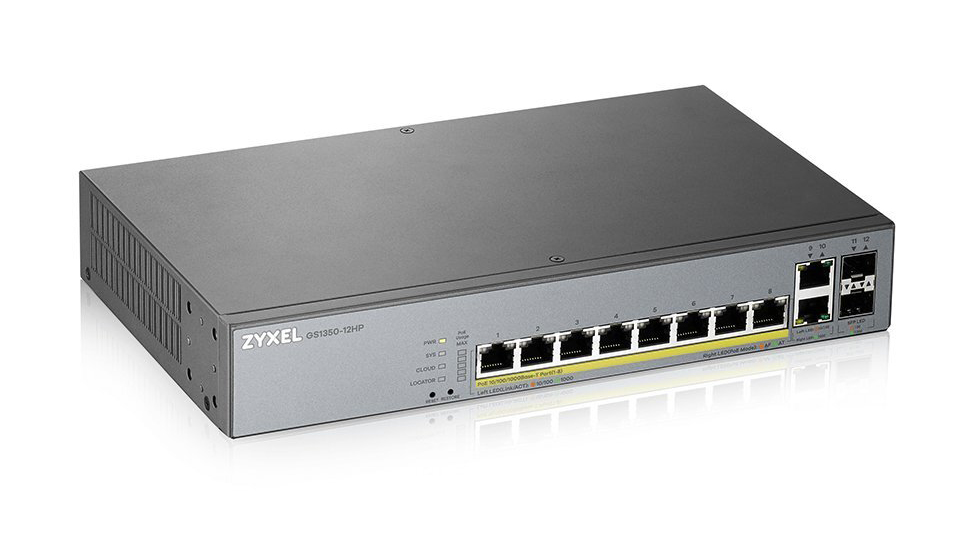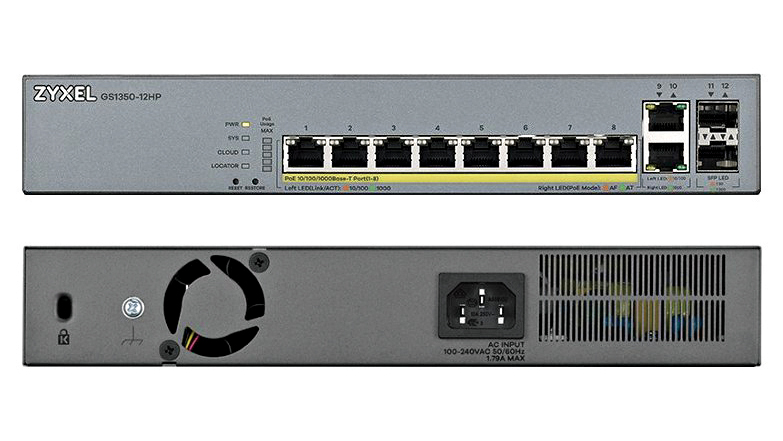Zyxel GS1350-12HP review: A security saviour
A smart PoE switch that puts self-healing surveillance networks firmly within an SMB price range


-
+
Brilliant Auto Recovery feature
-
+
Reasonable power budget
-
+
Easy to deploy
-
-
Unsuitable for devices handling high volumes of traffic
-
-
No graphical overview of ports in use

Zyxel’s GS1350 series of Layer 2 switches make perfectly fine general-purpose PoE switches, but they’re especially well-suited to driving IP cameras. The distinctive Auto Recovery feature keeps a watchful eye on all powered devices and can automatically power-cycle any that become unresponsive, while Zyxel’s patented surge protection circuitry also protects exterior cameras from lightning strikes.
The switch family comprises four models, ranging from the six-port GS1350-6HP up to the rackmount, 26-port GS1350-26HP. We tested the GS1350-12HP, which presents eight Gigabit Ethernet ports providing 802.3at PoE+ services, along with two pairs of unpowered copper and fibre dual-personality ports.
The unit has a reasonable power budget of 130W, and an extended-range mode that overcomes the 100m PoE cable length limitation, allowing powered devices to be placed up to 250m away. It can supply up to 15W of power in this mode, but it’s not suitable for devices that handle high volumes of traffic as – like most other PoE extenders – the link speed drops to 10Mbits/sec.
For management, you can use either the switch’s own web portal or the free Zyxel One Network (ZON) Windows utility. Root around the web console and you’ll also find the option to enable discovery by Zyxel’s Nebula Control Center cloud management platform: this is currently non-functional, but Zyxel plans to activate the feature in a few months.
The first time you access the web console, you’ll be greeted by a quick-start wizard that insists you change the default admin password and SNMP community name. Once you’re in, you might be a little disappointed to find that there’s no graphical overview of ports in use, but the console does provide plenty of information on switch utilisation, plus details of port and PoE usage; you can keep a close eye on individual power being supplied to each port, see the total draw and monitor power budget usage.

If you’re worried about breaching the power budget, each PoE port can be set to one of three priority levels, with lower-priority ports being automatically turned off should the drain reach the power threshold. You can also set up profiles to control when power is supplied to selected ports, using custom time schedules to automatically disable them when they’re not needed.
Then there’s the brilliant Auto Recovery feature, which uses either LLDP or Ping to verify that the device attached to a specified port is active, and cycles the power if it doesn’t receive a response after a set number of attempts. You can decide how often each port is polled, set the wait time between power cycles and tell the switch how many times it should turn the device off and on again before giving up. You can also generate an SNMP trap and log whenever an unresponsive device is rebooted, although email alerting isn’t supported.
Sign up today and you will receive a free copy of our Future Focus 2025 report - the leading guidance on AI, cybersecurity and other IT challenges as per 700+ senior executives
Lastly there’s the Neighbor web page, which shows the status of all powered devices, along with the IP addresses and hostnames of those that support LLDP. Coloured icons indicate whether each device is up, down or being rebooted, and you can manually force a power cycle on any port. If the device is an IP camera, you can open its web interface directly from the switch’s console simply by clicking on its IP address if displayed. Helpfully, if the switch itself needs to be rebooted – for example, for a firmware upgrade – this can be done without cutting the power and network connectivity for attached devices.
If your physical security is being compromised by flaky IP cameras, the GS1350-12HP could be the answer to your prayers, helping to ensure around-the-clock surveillance with no human intervention. It’s also good value, very easy to deploy and more than capable of regular switch duties, making it a top choice for small businesses.
Dave is an IT consultant and freelance journalist specialising in hands-on reviews of computer networking products covering all market sectors from small businesses to enterprises. Founder of Binary Testing Ltd – the UK’s premier independent network testing laboratory - Dave has over 45 years of experience in the IT industry.
Dave has produced many thousands of in-depth business networking product reviews from his lab which have been reproduced globally. Writing for ITPro and its sister title, PC Pro, he covers all areas of business IT infrastructure, including servers, storage, network security, data protection, cloud, infrastructure and services.
-
 US data center power demand forecast to hit 106GW by 2035, report warns
US data center power demand forecast to hit 106GW by 2035, report warnsNews BloombergNEF research reveals a sharp 36% jump in energy forecasts as "hyperscale" projects reshape the American grid
By Rene Millman Published
-
 Police Digital Service partners with BCS to overhaul law enforcement IT skills
Police Digital Service partners with BCS to overhaul law enforcement IT skillsNews The strategic alliance aims to professionalize the policing digital workforce, offering accreditation and support for the National Policing Digital Strategy 2025–2030
By Rene Millman Published
-
 ServiceNow to acquire Veza in major identity security play
ServiceNow to acquire Veza in major identity security playNews Veza’s AI-native identity security platform will be integrated into ServiceNow’s AI Control Tower to strengthen its identity and access controls
By Daniel Todd Published
